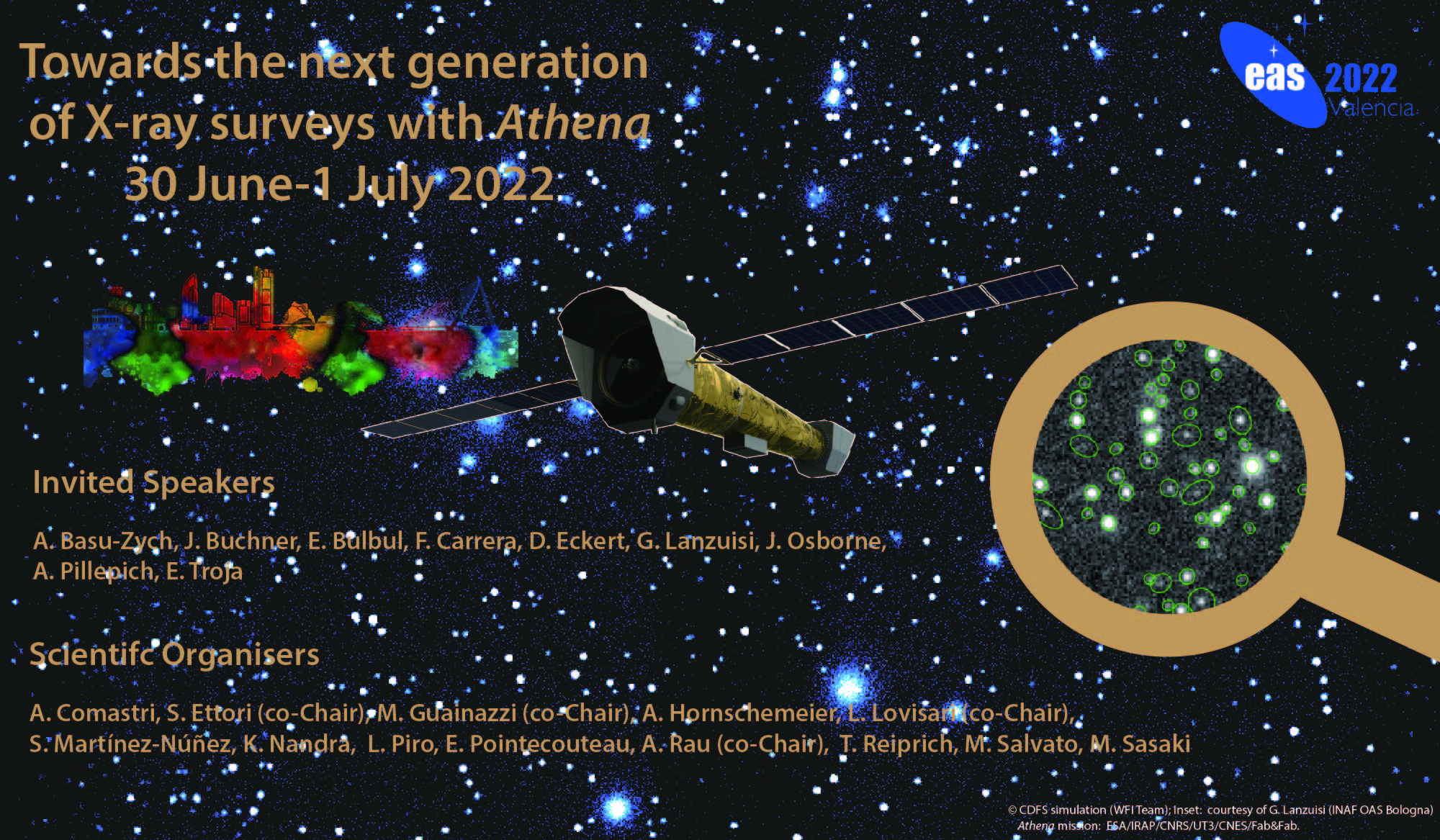
Towards the next generation of X-ray surveys with Athena
Aims and scope
The X-ray sky unveils the most energetic phenomena in the Universe and holds the keys to understanding the concurrent evolution of accreting supermassive black holes and their host galaxies, the evolution of the baryons locked in the largest known gravitationally-bound structures and the energetic counterparts to multi-messenger sources. Over the last two decades, large observatories like Chandra and XMM-Newton performed a number of surveys and generated catalogues of ~100,000 X-ray sources, predominantly Active Galactic Nuclei (AGN), groups and clusters of galaxies, and stellar objects. In addition to these observatories, the eROSITA instrument on-board the SGR mission started in 2019 its 4-year long all-sky survey. It will characterize cosmological models through a sample of ~100,000 galaxy groups and clusters up to redshift 1.2 while also enabling studies of ~3 million AGN out to the peak of the AGN density at redshift z~3-4. The survey will also provide sizeable samples of hitherto rare events associated with X-ray transients and variables, and map the largest structures in our Galaxy and Extragalactic neighbourhood.
- The next generation large X-ray survey facility will be the ESA Athena observatory with its Wide Field Imager (WFI) instrument. Currently in Phase B and planned for launch in ~2034, Athena and the WFI will provide an unprecedented combination of grasp and energy resolution by utilizing DEPFET active pixel sensors covering a 40'x40' field of view in the focal plane of a 12-m telescope with requirements of a 1.4 squared meter effective area and 5" Half-Energy Width at 1 keV. The mission will be able to carry out Target-of-Opportunity observations as fast as 4 hours and have access to >50% of the whole sky at any time. This combination of instrument and mission capabilities will facilitate transformational advancements in a large number of areas, including
- Extend to z>1 the cosmological studies pioneered by the galaxy clusters detected by eROSITA, by mapping the properties of low-mass galaxy groups up to z~2, and allowing (i) to study the interplay between metal enrichment, development of the ICM and feedback, (ii) to evaluate how these phenomena impact the energetic and baryonic distributions of the ICM and the cosmological evolution of basic thermodynamic scaling relations, (iii) to highlight the level of deviations from the self-similar scenario and the differences with galaxy clusters.
- Perform a comprehensive survey of accreting supermassive black holes over a wide range of luminosity and redshift to inform the cosmological models describing their birth, growth and evolution.
- Contribute to identifying sources of missing baryons that could be locked in tenuous degree-scale hot gas filaments surrounding clusters (as those recently discovered by eROSITA in Abell 3391-3395), as well as measuring the mass, baryon and metal budget of the circumgalactic medium surrounding our Galaxy and other nearby galaxies.
- Probe population of faint black holes and neutron stars in nearby galaxies, determining the processes regulating their growth.
- Search for the electromagnetic counterparts of multi-messenger events (as detected by ground-based and space-born gravitational waves experiments such as LISA, or neutrino experiments), or other fast X-ray transient events.
The Athena/X-IFU micro-calorimeter detector with a 2.5 eV energy resolution, will enable synergistic high-spectral resolution observations of selected sources or sky regions identified in the Athena/WFI survey.
The Symposium aims at summarizing the latest observational progress brought by the ongoing X-ray surveys and addressing the prospective advancements to be achieved by Athena in all the above fields.
Programme
The programme - available in PDF here - is structured in four thematic blocks:
- AGN population and evolution studies
- Formation and evolution of large-scale structures (from WHIM to IGM/ICM) and cosmology
- Survey of the Galaxy and nearby galaxies
- Transient sources and multi-messenger astrophysics
Furthermore, there is a standalone session to present the status of the mission and payload design.
Invited Speakers
Antara Basu-Zych, Johannes Buchner, Esra Bulbul, Francisco Carrera, Dominique Eckert, Giorgio Lanzuisi, Julian Osborne, Annalisa Pillepich, Eleonora Troja.
Scientific Organisers
Andrea Comastri, Stefano Ettori (co-Chair), Matteo Guainazzi (co-Chair), Ann Hornschemeier, Lorenzo Lovisari (co-Chair), Silvia Martínez-Núñez, Kirpal Nandra, Luigi Piro, Etienne Pointecouteau, Arne Rau (co-Chair), Mara Salvato, Thomas Reiprich, Manami Sasaki.
Online presentations:
The presentations are open access to the astronomical community at the Athena document repository. In addition, the invited talk - The Athena X-ray observatory: prospective science and mission status, by Francisco J. Carrera - is public on the ACO Youtube channel.


